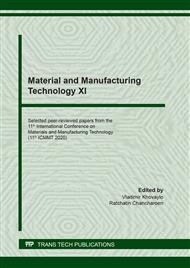p.73
p.83
p.90
p.96
p.102
p.108
p.114
p.123
p.131
Study of Ni2+/Ni3+ Redox Couple and Electrocatalytic Responses of Ni on Nitrogen-Doped Carbon for Urea Non-Enzymatic Detection
Abstract:
A novel redox couple of metallic nickel (Ni) catalyst can become a great candidate of non-enzymatic detection. By taking advantage of fast electron transfer, Ni redox couples can be tailored as pseudo-enzyme in urea measurement. In this study, Ni catalyst on nitrogen doped carbon (Ni-NC) was synthesized and characterized morphological, elemental, and electrocatalytic properties in comparison to different configuration of pure nickel (Ni), Ni with carbon (Ni-C), and bare carbon electrode, assessed by cyclic voltammetry and differential pulse voltammetry. By examining various Ni redox couples in rapid electron transfer process, the prominent anodic and cathodic peaks of Ni2+/Ni3+ were applicable to detect urea in the detection range of 1-20 mM, with an excellent sensitivity and relative standard deviation of 1.634 μA.mM-1 (R2 of 0.989) and 4.89%, respectively. Therefore, Ni-NC can find practical applications for material sensing device toward non-enzymatic urea measurement.
Info:
Periodical:
Pages:
102-107
Citation:
Online since:
February 2021
Authors:
Price:
Сopyright:
© 2021 Trans Tech Publications Ltd. All Rights Reserved
Share:
Citation:


